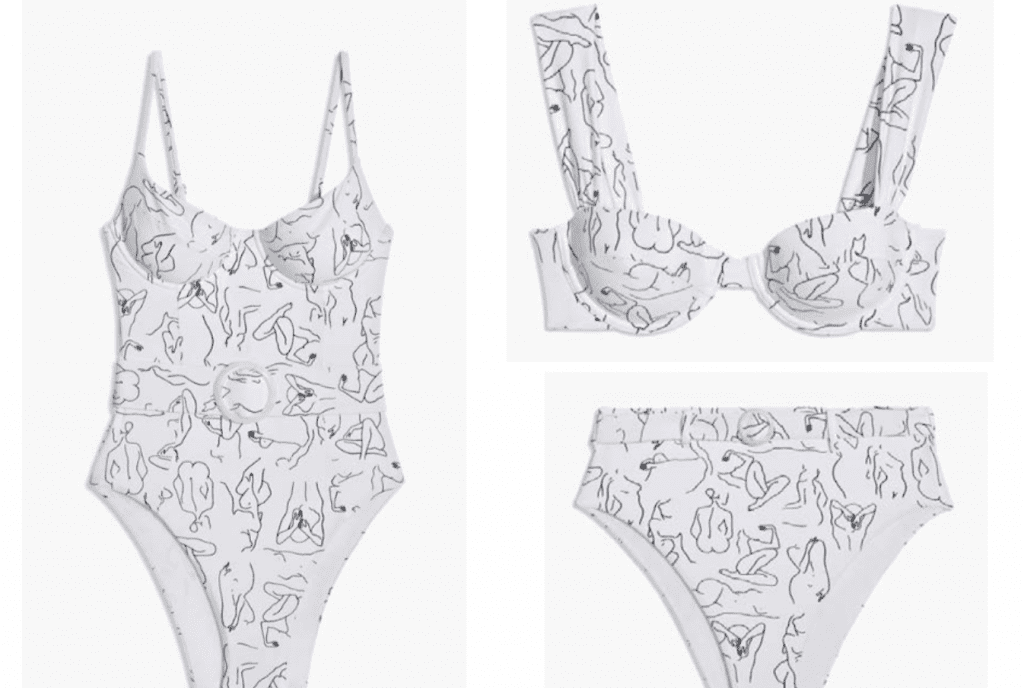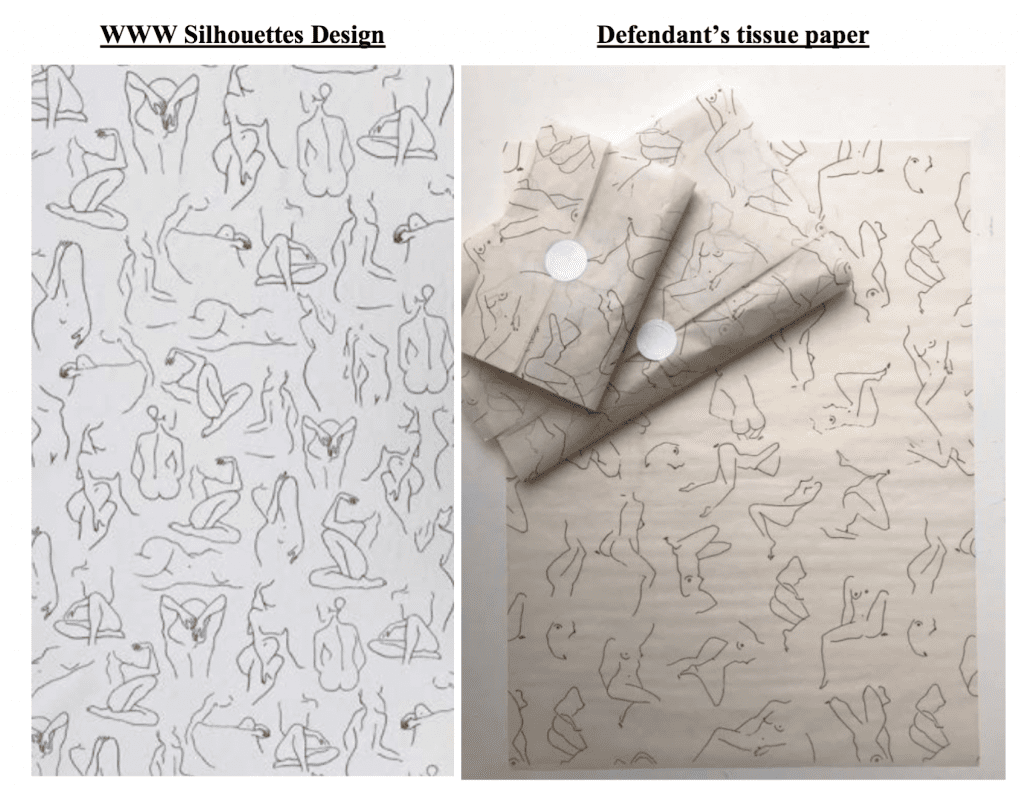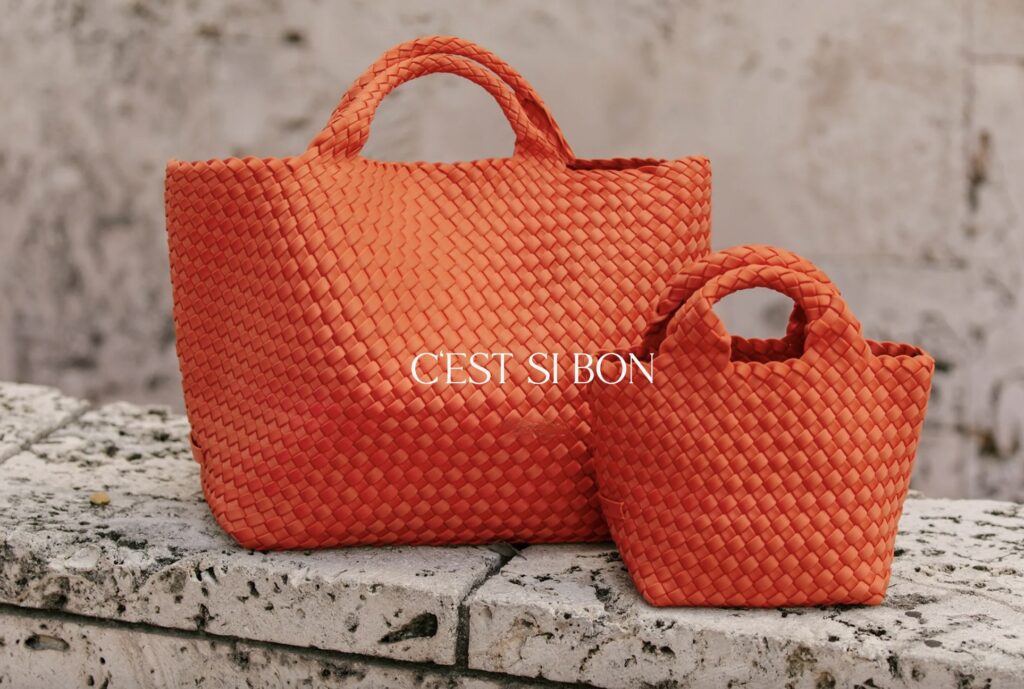The online call-out feud that erupted this summer between heavily-followed influencer Danielle Bernstein’s WeWoreWhat (“WWW”) and intimates brand The Great Eros has morphed into a full-blown legal battle. Counsel for WeWoreWhat LLC and Onia LLC filed suit against CV Collection, LLC, d/b/a The Great Eros on Thursday, asking a New York federal court to formally declare that despite The Great Eros’s allegations to the contrary, a pattern used by WWW “does not infringe or otherwise violate [The Great Eros’s] purported copyright or any other rights under the Lanham Act or common law.”
According to the newly-filed complaint, WWW reveals that it has been engaged in a behind-the-scenes back and forth with The Great Eros ever since the Brooklyn, New York-based brand first sent it a cease and desist letter on August 10, in which it accused WWW of “committing copyright infringement and engag[ing] in unfair competition via its use of the WWW Silhouettes Design” on swimwear and activewear offerings. WWW’s use of the Silhouettes Design represents an “unauthorized reproduction” of The Great Eros’s “famous artwork and trade dress,” the brand argued in its cease and desist letter, pointing to the silhouette-centric pattern that it uses on its own product packaging.
Responding to The Great Eros’ letter on August 13, counsel for WWW – the offshoot of Bernstein’s “world-renowned fashion blog” of the same name – denied the allegations, asserting that “the WWW Silhouettes Design was independently created, and that WWW ‘did not copy, use, or reproduce any artwork belonging to The Great Eros,’ nor did anyone at WWW or associated with WWW ever purchase product from The Great Eros or receive product wrapped in the tissue paper.”
WWW further asserted in response to The Great Eros’s letter that the Silhouettes Design – which WWW says that it first released in early 2020 – is not a copy of the company’s print, and instead, “was inspired by the generally ubiquitous concept of silhouette drawings of the human form along with a number of Henri Matisse’s line drawings.” In that same letter, WWW claims that its “counsel identified extensive third party designs of silhouettes of the human form, noting ‘widely accessible and similar designs in the market place,’ and provided examples of ‘similar themed’ products.”
After The Great Eros allegedly failed to provide WWW with any “evidence that [it] had to support its claims” of infringement (including that WWW copied the tissue paper design, that it had access to the print, or “that the sections of the tissue paper design that [The Great Eros] alleges that WWW’ copied are protected by copyright”), WWW claims that on October 13, it received an email from The Great Eros, in which the company “made an actual threat to file a district court litigation later this week against [WWW],” and attached a draft of the complaint that it was threatening to file in court.
As a result of the alleged threat of litigation from The Great Eros, WWW was seemingly prompted to file a suit of its own, asserting that “as with the letter and email correspondences, [The Great Eros] continues to fail to allege … that [the] WWW Silhouettes Design is ‘substantially similar’ to that of [its] tissue paper design which shows their alleged copyright claim is not valid or credible.” (Substantial similarity is the standard for gauging whether two works are similar enough to give rise to a finding of copyright infringement).
WWW argues that the two parties’ prints are not “substantially similar,” and in fact, “WWW Silhouettes Design is substantially different from [The Great Eros’s] tissue paper,” given that the “WWW Silhouettes Design includes rounded curves of the head, arms, legs, and buttocks, [while The Great Eros’s] tissue paper design has sharp points.” Moreover, WWW claims that its “Silhouettes Design includes the back of heads on multiple sitting women,” whereas The Great Eros’s “tissue paper design does not have any heads on any of its silhouettes.”
In case these differences, among others, are not enough, WWW – which has faced allegations of copying on more than one occasion in the past – argues that “no one, including the defendant, owns the concept of silhouettes of the human form.” As such, it says that it should be shielded from The Great Eros’s infringement claim, especially given that even if The Great Eros’s “purported copyright rights” are valid, they are “are exceedingly narrow in scope such that [WWW’s] sales, advertisements and marketing activities do not constitute an infringement of [The Great Eros’s] purported rights.”
(In accordance with copyright law, when the amount of creativity or originality in a work is low, including because there are only so many ways to depict a certain thing, potentially such as a silhouette of the human body, the level of copyright protection afforded to the copyright holder is deemed to be “thin.” As a result, while protection exists, infringement claims are generally limited to literal copying, or instances in which the allegedly infringing work is “virtually identical” to the copyright holder’s work).
In addition to a declaration that it is not infringing The Great Eros’s alleged copyright and that Great Eros “is not entitled to any injunctive relief or damages under the Copyright Act,” WWW also asked the court to formally declare that it has not engaged in unfair competition (i.e., any unlawful, unfair, or fraudulent business act or practice, or false, deceptive, or misleading advertising) given that its “goods are labeled, advertised, marketed and sold in such a manner that there is no likelihood of confusion between [The Great Eros’s] goods sold wrapped in tissue paper bearing the purposed copyrighted design on one hand, and the sale of goods using WWW’s Silhouettes Design on the other.”
(For the uninitiated, a declaratory judgment differs from other types of judgments in that it is a binding opinion from a court that defines the legal relationship between parties and their rights in the matter at hand. Unlike in a traditional judgment, in issuing a declaratory judgment, a court is not ordering either of the parties to take any action or awarding any damages for violations of the law. Instead, declaratory judgments state whether the parties may seek or are entitled to relief.)
Jeff Gluck, counsel for The Great Eros, told TFL on Friday, “This misguided charade is nothing more than yet another nasty attempt by Danielle Bernstein to intimidate and silence independent creatives and small business owners. She believes that rules don’t apply to her. This type of privileged and entitled mindset may have worked for her in the past, but it stops now. We will be relentless in our pursuit of justice on behalf of The Great Eros and the entire independent small business and creative communities. She secretly filed this lawsuit while pretending to hold settlement talks. I have never seen anything slimier in more than a decade of practicing law. If she wants a war, we are very happy to oblige. My client and my firm are grateful to everyone for the incredible outpour of support.”
*The case is WEWOREWHAT, LLC, and ONIA, LLC, v. CV COLLECTION, LLC, d/b/a THE GREAT EROS, 1:20-cv-08623 (SDNY).












